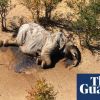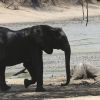-
 +13 +1
+13 +1This is what years of tourist rides do to an elephant
Elephants may be known for their size and strength, but tourists who ride on their backs can still do great harm, as this photo shared by a wildlife rescue group in Thailand shows.
-
 +3 +1
+3 +1Elephant study could reduce conflict with humans
Younger male elephants' aggression is reduced in the presence of older male elephants, a study finds. The findings could aid in elephant conservation.
-
 +21 +1
+21 +1How elephants may offer clues to cancer resistance
A new study explains how elephants evolved to be both large and cancer resistant.
-
 +4 +1
+4 +1Elephants have evolved to be tuskless because of ivory poaching, a study finds
A hefty set of tusks is usually an advantage for elephants, allowing them to dig for water, strip bark for food and joust with other elephants. But during episodes of intense ivory poaching, those big incisors become a liability.
-
 +21 +1
+21 +1Wildlife photographer captures a beautiful image of an elephant in front of a double rainbow
This beautifully timed photograph shows the moment an African elephant appears to pose for a photograph in front of a rainbow.
-
 +11 +1
+11 +1Elephant Trunks: Is There Anything They Can’t Do?
A new study highlights the impressive biomechanics and suction power of an elephant’s most defining appendage.
-
 +18 +1
+18 +1Elephants are dying in droves in Botswana. Scientists don’t know why
Some type of pathogen may be behind the recent deaths of 39 elephants, a new wave that follows 350 deaths last summer.
-
 +9 +1
+9 +1Forest elephants are now critically endangered -- here's how to count them
A team of scientists led by the Wildlife Conservation Society (WCS) and working closely with experts from the Agence Nationale des Parcs Nationaux du Gabon (ANPN) compared methodologies to count African forest elephants (Loxodonta cyclotis), which were recently acknowledged by IUCN as a separate, Critically Endangered species from African savannah elephants.
-
 +3 +1
+3 +1How elephants evolved to become big and cancer-resistant
A study shows that elephants possess a large toolbox of genes for evading cancer, and suggests that evolution of tumor suppression capabilities contributed to the development of big bodies.
-
 +14 +1
+14 +1Ivory from a 16th century shipwreck reveals new details about African elephants
In 2008, miners off the coast of Namibia stumbled upon buried treasure: a sunken Portuguese ship known as the Bom Jesus, which went missing on its way to India in 1533. The trading ship bore a trove of gold and silver coins and other valuable materials. But to a team of archaeologists and biologists, the Bom Jesus’ most precious cargo was a haul of more than 100 elephant tusks — the largest archaeological cargo of African ivory ever discovered.
-
 +20 +1
+20 +1Thai man revives baby elephant with CPR after motorbike accident
A baby elephant struck by a motorbike while crossing a road in Thailand survived after it was revived by an off-duty rescue worker. Mana Srivate told Reuters news agency he had performed dozens of resuscitation attempts in his career - but never before on an elephant.
-
 +15 +1
+15 +1The moment the 'world's loneliest elephant' makes his first friend in years
An elephant who was rescued from Pakistan is settling into his new home in Cambodia – touching trunks with his new friends. Footage shows the 36-year-old male jumbo named Kaavan at the Cambodia Wildlife Sanctuary in Siem Reap province. At sunrise, he enjoyed a refreshing mud bath then met one of his new neighbours, Di Poh, and they greeted each other by touching the tips of their trunks.
-
 +15 +1
+15 +1'World's Loneliest Elephant' Moving To Sanctuary, With Help From Cher
Singer Cher was in Pakistan on Friday with a message for "the world's loneliest elephant": There is life after love. Kaavan the elephant has been languishing in poor conditions in Marghazar Zoo in Islamabad since 1985, according to the animal welfare group Four Paws International. He was brought there as a gift from Sri Lanka at 1 year old.
-
 +11 +1
+11 +1Scientists discover Stegodon elephant fossil in Malaysian cave
Scientists from Universiti Malaya (UM) have identified the fossil of an extinct elephant in a limestone cave in Gopeng, Perak in Malaysia. The country’s first discovery of Stegodon fossil is estimated to have a geological age of between 30,000 and 80,000 years and is said to be a milestone in the field of Quaternary palaeontological studies in Malaysia.
-
 +18 +1
+18 +1Organizers Offer Zoom Video Conferences With Elephants in Northern Thailand
The Elephant in the Zoom: elephants in northern Thailand offered to organisers of video call meetings to help raise funds for their care
-
 +27 +1
+27 +1Kenya's elephant numbers double over three decades
Kenya's elephant population has more than doubled from 1989 to today, its wildlife service announced at an event marking World Elephant Day. Tourism Minister Najib Balala said authorities have "managed to tame poaching."
-
 +3 +1
+3 +1The Silent Crisis: Vietnam’s Elephants on the Verge of Extinction
As the slaughter of the remaining elephants in Africa continues without interruption, elephants in Vietnam—without media attention and a pack of NGOs calling for their protection—are quietly disappearing. Victim of an intensely and increasingly fragmented habitat, weak environmental laws, human-elephant conflicts, logging, and poaching, elephants in Vietnam are teetering on extinction.
-
 +1 +1
+1 +1Hundreds of elephants dead in mysterious mass die-off
Botswana’s government is yet to test the remains of the dead animals in what has been described as a ‘conservation disaster’
-
 +12 +1
+12 +1More than 100 elephants die amid severe drought in Zimbabwe
Weak from hunger and thirst, the elephant struggled to reach a pool of water in this African wildlife reserve. But the majestic mammal got stuck in the mud surrounding the sun-baked watering hole, which had dramatically shrunk due to a severe drought. Eventually park staff freed the trapped elephant, but it collapsed and died. Just yards away lay the carcass of a Cape buffalo that had also been pulled from the mud, but was attacked by hungry lions.
-
 +4 +1
+4 +1Should the Clearly Extinct Woolly Mammoth Be Reclassified as Endangered?
IF YOU SHAVED THE WOOLINESS from a woolly mammoth, from trunk to tail, it would still be easy to see its relationship to its extant cousins, the elephants. There’s the overall size and shape, and the prominent head ridge and of course the trunk, and also the tusks—though those actually help distinguish a mammoth from an elephant, since they’re so massive and audaciously curved. But ivory is ivory, and both pachyderms’ tusks sell for a pretty penny, though only mammoth ivory is legal in many markets.
Submit a link
Start a discussion




















